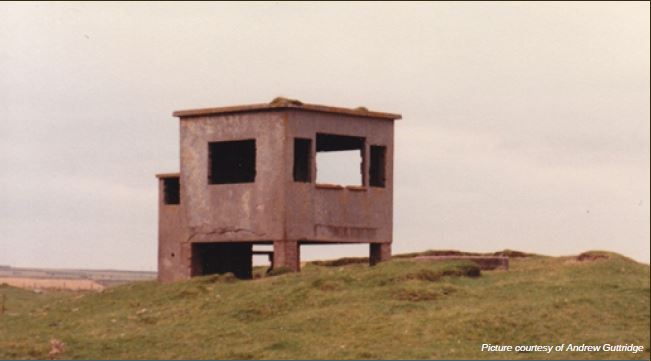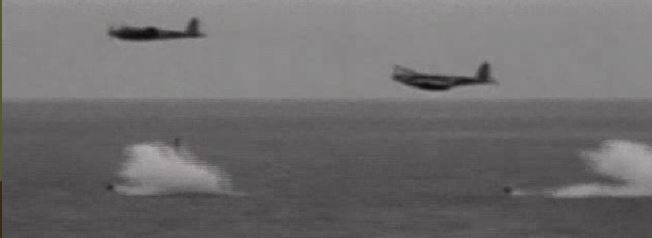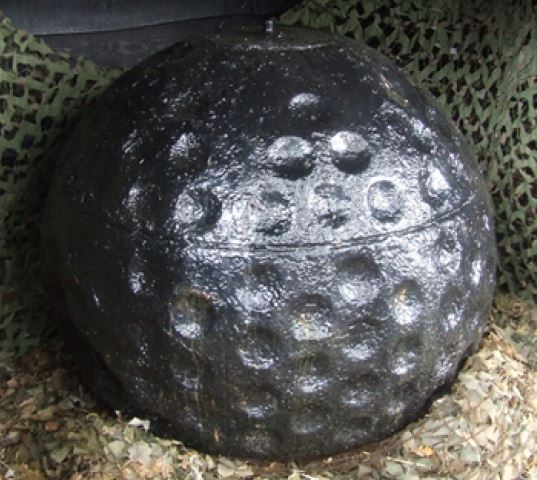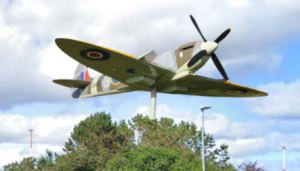Site 13. Sinclair’s Bay Bombing Ranges & Quadrant Shelter
During WW2 the Coastal Command aerodrome at Wick was a vital strategic air base in the Battle of the Atlantic. Thousands of sorties were flown from RAF Wick by aircraft of many different types, searching for and attacking German U-boats and surface vessels with bomb, torpedo, rocket, machine gun and cannon. Training and practice in the use of these weapons was needed and so ranges were created in Sinclair’s Bay.
The bombing range was simply a designated area of sea, at the southern end of the bay, where a floating raft provided a target onto which aircraft could drop practice bombs, no live munitions were used for this. Bombs which gave off a plume of smoke were used during daytime and for nighttime practice flash bombs, which gave an intense flash of light, were used. The target was normally a triangular shaped raft, about 32 ft along the sides, and painted yellow moored about 1,500 yards off the beach. A wicker ball on top of a pole at the centre of the raft was the sighting point.
It was clearly necessary to know how accurately, or otherwise, an aircraft had dropped its bomb, so the exact point of impact had to be known. This was found by observing the angle of the bomb’s impact from two positions along the coast. Two Quadrant Shelters were built on the coast for this purpose, positioned such that they faced towards the target area and their angle of sight on the target was at 90° to each other. From these shelters observers could measure the angle of the plume of smoke from the bomb using a Quadrant Sight, a simple sighting scope attached to a base plate with degrees marked on it. These angles were communicated to the Plotting Room at Wick airfield where they were plotted onto a ‘Range Chart’ and an accurate indication of where the bomb had landed, and therefore the crew’s accuracy, could be determined.

On Sinclair’s Bay the No 1 Quadrant Shelter was located just north of Ackergill tower. Beside the shelter was the Range Marker, which consisted of a large arrow laid out on the ground and pointing towards the target. This was surrounded by three discs and two stripes, used to indicate current range conditions to the pilot. A nearby Nissen hut may have been a messing hut for the range staff, who would normally include a range control officer or senior NCO and two spotters per quadrant, and a radioman. Unfortunately, this has all now been lost to quarrying work. No. 2 shelter is located east of Ackergill harbour. The shelters were connected to each other and to the plotting room at Wick airfield by field telephones, these were replaced later on when VHF radios became more widely available.

An old shipwreck at the north end of the Sinclair’s Bay became the target for a second range, this was used for air-to-ground live firing practice with .303” machine gun, 20mm cannon and 3” rocket weapons. When the ranges were due to be used a red flag was raised at the Quadrant Shelters, and at night a red light was shown.

Torpedo attack training was also carried out in Sinclair’s Bay. These did not use a torpedo but were a simulated attack which could be carried out on any passing naval vessel willing to co-operate. The aircraft was fitted with cameras on the underside of its wings which, when the pilot pressed the torpedo release button, captured the view in front of the aircraft at that instant. An observer on the ship would also watch the aircraft’s attack run and report his observations to the plotting room at the airfield. From this information it would be decided if the theoretical attack had been a success or not. As this could be carried out anywhere where a co-operative ship was present it didn’t require a specific range area.
Possibly the most interesting use of Sinclair’s Bay for bombing practice was that carried out by the Mosquito aircraft of 618 Squadron while training for a Top-Secret mission.

No. 618 Sqn was formed at nearby RAF Skitten in early April 1943 under conditions of extreme secrecy. She was sister squadron to its more famous counterpart, No. 617 (Dambusters) Squadron. The purpose of these squadrons was to deliver Barnes Wallis’ specially designed ‘bouncing’ bombs against specific targets. 617’s targets were the Ruhr dams in Germany, whilst 618’s was the German Battleship, Tirpitz. The bombs used by each squadron were slightly different in that 617’s‘Upkeep’ bombs were cylindrical whilst 618’s ‘Highball’ bombs were spherical.
The aircraft used were de Havilland Mosquitos, specially adapted to carry two Highball bombs. The squadron spent their time familiarising themselves with their aircraft and the characteristics of the weapon they were to carry, developing techniques and gaining the experience needed to deliver these oddball weapons accurately and consistently. Part of this involved releasing the bomb from the aircraft at very low level (60 ft) at high speed. This was practiced over Sinclair’s Bay where, between 17th August and 1st September 1943, approximately 60 Highball bombs were dropped. These were all ‘dummy’ bombs, filled with concrete instead of explosives, and all of which still lie at the bottom of Sinclair’s Bay to this day.



